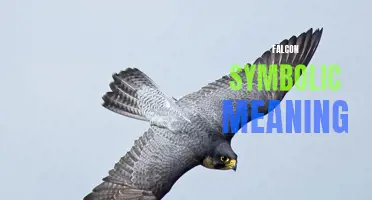
Norway, with its stunning natural beauty, rich history, and vibrant culture, is a country filled with symbols and meanings that reflect the essence of its people and heritage. From the majestic fjords to the mythical trolls, and the iconic Viking ships to the national bunad costumes, Norwegian symbols encapsulate the pride, traditions, and values of this Nordic nation. These symbols not only tell stories but also establish a sense of identity and belonging for Norwegians, connecting them to their past while guiding them towards their future. Join us on a captivating journey through the significant symbols and their intriguing meanings that contribute to the enchanting tapestry of Norwegian culture.
What You'll Learn
- What are some common Norwegian symbols and their meanings?
- Why is the Norwegian flag such an important national symbol?
- Are there any traditional Norwegian symbols related to nature or wildlife?
- What is the significance of the stavkirke (stave church) as a symbol in Norway?
- Can you explain the meaning behind the Norwegian troll as a cultural symbol?

What are some common Norwegian symbols and their meanings?
Norway, known for its stunning landscapes and rich cultural heritage, also boasts several symbols that hold great importance to its people. These symbols range from ancient Viking imagery to more modern symbols that represent the country's values and culture. Here are some common Norwegian symbols and their meanings:
- Viking Ship: The Viking ship is an iconic symbol of Norway's legendary seafaring past. These ships were used by the Vikings for exploration, trade, and conquest. Today, the Viking ship represents bravery, strength, and adventure.
- Stave Church: Stave churches are wooden churches that date back to the medieval period in Norway. These churches are known for their unique wooden architecture and intricate carvings. The stave church symbolizes Norway's Christian heritage and its close connection to nature.
- Bunad: The bunad is a traditional Norwegian folk costume worn on special occasions and holidays. Each region in Norway has its own distinctive bunad design, representing local customs and traditions. The bunad symbolizes national pride and cultural identity.
- Rosemaling: Rosemaling is a traditional decorative painting style that originated in Norway. It features intricate floral motifs and vibrant colors. Rosemaling is often used to adorn wooden objects, furniture, and textiles. This art style symbolizes craftsmanship, creativity, and the beauty of nature.
- Sami Duodji: The Sami people are the indigenous inhabitants of the northern regions of Norway, Sweden, Finland, and Russia. Sami duodji refers to their traditional handicrafts, which include items like reindeer skin clothing, silver jewelry, and wooden objects. Sami duodji symbolizes the importance of preserving and celebrating indigenous cultures.
- Hardanger Embroidery: Hardanger embroidery is a traditional embroidery technique from the Hardanger region of Norway. It is characterized by its geometric patterns and cutwork designs. Hardanger embroidery represents the skill and precision of Norwegian craftsmanship.
- National Flag: The Norwegian national flag, commonly known as the "Nordic Cross Flag," features a red background with a white cross. The flag symbolizes Norway's independence and sovereignty. It is also a proud symbol of national unity and patriotism.
- Northern Lights: The Northern Lights, or Aurora Borealis, are a natural phenomenon that can be seen in the northern parts of Norway. These vibrant lights dancing across the night sky symbolize the magic and beauty of the Arctic region.
These symbols play an important role in Norwegian culture, representing the country's history, traditions, and natural wonders. They serve as reminders of Norway's rich heritage and contribute to the country's unique identity. Whether it's the Viking ship symbolizing bravery or the bunad representing cultural pride, these symbols hold deep meanings for Norwegians and are celebrated and cherished in various aspects of Norwegian life.
Unveiling the Symbolism and Meanings Behind Diwali, the Festival of Lights
You may want to see also

Why is the Norwegian flag such an important national symbol?
The Norwegian flag, also known as the "Flag of Norway" or the "Norwegian national flag," holds significant importance for the people of Norway. It represents their national identity, history, and values, and serves as a symbol of unity and pride for the nation.
The Norwegian flag, which consists of a red background with a blue Scandinavian cross that extends to the edges of the flag, holds a rich historical significance. It dates back to the early 19th century when Norway obtained independence from Denmark in 1814. The design of the flag was inspired by the Danish flag, reflecting the close historical ties between the two countries.
The flag was officially adopted by Norway on July 17, 1821, making it one of the oldest national flags in the world. It became a powerful symbol of Norwegian independence and sovereignty, representing the country's break from its union with Denmark. Today, July 17th is celebrated as the Norwegian Flag Day, a national holiday that commemorates the adoption of the flag.
The Norwegian flag also symbolizes the values and principles that are important to the Norwegian people. The red color represents bravery, strength, and perseverance, while the blue cross symbolizes freedom, unity, and democracy. These values are deeply ingrained in Norwegian society and play a significant role in shaping the country's culture, laws, and policies.
The flag's importance can also be seen during national events and celebrations. It is proudly displayed during constitutional holidays, such as Norwegian Constitution Day on May 17th, when Norwegians come together to celebrate their nation's independence and heritage. The flag is seen flying high in streets, on buildings, and even on people's clothing, showcasing their love and respect for their country.
Furthermore, the Norwegian flag is a unifying symbol for all Norwegians, regardless of their background or beliefs. It represents a sense of belonging and unity, bringing together people from diverse backgrounds and regions under a common identity. It reminds Norwegians of their shared history, culture, and accomplishments, fostering a sense of national pride and solidarity.
In recent years, the Norwegian flag has gained international recognition and admiration. Its simple yet bold design, combined with its historical significance and values, has made it a recognizable symbol around the world. The flag is often displayed at international events and conferences, proudly representing Norway and its people on the global stage.
In conclusion, the Norwegian flag holds immense importance as a national symbol for the people of Norway. It represents their history, values, and unity, and serves as a visual representation of their national identity. The flag's significance is deeply rooted in Norwegian society and is cherished by all Norwegians, making it a powerful emblem of their pride and patriotism.
Eye of Odin Symbol Meaning: Unveiling the Secrets of Norse Mythology
You may want to see also

Are there any traditional Norwegian symbols related to nature or wildlife?
Norway, with its stunning landscapes and rich biodiversity, has a deep connection to nature and wildlife. The country is home to various symbols that represent its natural beauty and the importance of preserving its ecosystems. These symbols showcase Norway's cultural heritage and reflect the close bond between the Norwegian people and their surroundings. Let's explore some traditional Norwegian symbols related to nature and wildlife:
- The Norwegian Flag: The national flag of Norway, known as "Norges flagg," incorporates elements of nature and wildlife. The flag features a blue Scandinavian cross with a white background, representing the clear blue sky and drifting snow. The colors symbolize Norway's pristine environment and its connection to the Arctic region.
- The Stave Church: Stave churches are a distinctive style of wooden church found in Norway. These churches are often adorned with intricate carvings of animals and mythical creatures. The depictions of animals, such as dragons, lions, and birds, symbolize the close relationship between nature, spirituality, and the Norwegian people.
- The Troll: In Norwegian folklore, trolls are mythical creatures closely associated with nature and wildlife. They are said to dwell deep in the forests, mountains, and fjords of Norway. Trolls represent the untamed and wild aspects of nature and serve as a reminder of the country's rugged landscapes and deep connection to the natural world.
- The Sami People: The Sami people are indigenous to the northern parts of Norway, Sweden, Finland, and Russia. They have a rich cultural heritage deeply rooted in a harmonious relationship with nature. The traditional Sami symbols often include reindeer, which are essential to their way of life. Reindeer represent the interdependence between humans and animals in the Arctic region and symbolize the Sami people's strong connection to nature and wildlife.
- The Midnight Sun and Northern Lights: Norway is known for its unique natural phenomena, such as the midnight sun and the aurora borealis, also known as the northern lights. These enchanting phenomena have been a source of inspiration for Norwegian artists and poets for generations. They represent the awe-inspiring beauty and magic of the natural world, reminding Norwegians of the importance of protecting their natural heritage for future generations.
In conclusion, Norway has a deep appreciation for nature and wildlife, which is evident in its traditional symbols. These symbols celebrate the country's rich natural heritage and emphasize the close connection between the Norwegian people and their surroundings. From the national flag to mythical creatures and indigenous traditions, these symbols remind Norwegians and visitors alike of the intrinsic value of preserving and cherishing nature.
What Does the Eye Symbol Mean on TikTok? Exploring the Hidden Secrets Behind the Mysterious Emoji
You may want to see also

What is the significance of the stavkirke (stave church) as a symbol in Norway?
Norway is renowned for its rich cultural heritage, and one of the most iconic and symbolic structures in the country is the stavkirke, also known as a stave church. These medieval wooden churches, with their distinctive architectural style, have played a significant role in Norway's history and cultural identity.
Stave churches were built primarily during the Middle Ages, between the 12th and 14th centuries. They were constructed using a unique construction technique that involved a framework of vertical wooden posts, or staves, which gave the churches their name. The wooden staves were intricately carved and connected by horizontal timber beams, creating an incredibly sturdy and durable structure.
The stavkirke design is a blend of Viking and Christian architectural influences. The interiors of the churches feature intricate wood carvings depicting scenes from the Bible, Norse mythology, and local folklore. The exteriors often display intricate dragon heads and other decorative elements.
The stavkirke holds great significance in Norwegian history and culture for several reasons. First and foremost, these churches were places of worship and played a crucial role in the Christianization of Norway. They provided a physical space for religious ceremonies, baptisms, weddings, and funerals, serving as a focal point for the local community.
Additionally, stavkirkes are a testament to the impressive craftsmanship and engineering skills of the Norse people. The intricate wood carvings and detailed ornamentation display the mastery of Norwegian artisans, while the durable construction methods have allowed many of these churches to withstand the test of time.
The stavkirke also represents a unique blend of pagan and Christian beliefs. The carvings and decorations often incorporate elements of Norse mythology, such as dragons and serpents, alongside Christian symbols like crosses and saints. This synthesis of different religious traditions reflects the complex historical and cultural context in which these churches were built.
Furthermore, the stavkirke is a symbol of national pride and identity for the Norwegian people. These churches are seen as a distinctive feature of the Norwegian landscape and are often used as a symbol of Norway in international contexts. Stavkirkes are frequently featured in tourist brochures and promotional materials, showcasing Norway's rich cultural heritage and attracting visitors from around the world.
Today, there are only a few well-preserved stavkirkes remaining in Norway, but they continue to hold great cultural and historical significance. The most famous example is the Urnes Stave Church, which is recognized as a UNESCO World Heritage Site. These churches are not only preserved as historical landmarks but are also actively used for religious services and cultural events, ensuring that their legacy lives on.
In conclusion, the stavkirke symbolizes the rich history, cultural identity, and craftsmanship of Norway. These medieval wooden churches played a vital role in Norway's Christianization, displaying a unique blend of Norse and Christian influences. Today, they continue to inspire awe and admiration, serving as a testament to Norway's cultural heritage and as physical reminders of the country's past.
Decoding the Symbols: Understanding the Meaning Behind Plat Map Symbols
You may want to see also

Can you explain the meaning behind the Norwegian troll as a cultural symbol?
The Norwegian troll holds a significant place in Norwegian folklore and culture. These mythical creatures are known for their distinct appearance and mischievous behavior. Let's dive deeper into the meaning behind the Norwegian troll as a cultural symbol.
In Norwegian folklore, trolls are considered supernatural beings that dwell in the mountains, forests, and sometimes even underground. They are depicted as large, hulking creatures with grotesque features such as long noses, hairy bodies, and tails. Some trolls are said to have multiple heads or appendages, adding to their fearsome appearance.
Trolls are often portrayed as guardians of nature, living in harmony with their surroundings. They have a deep connection to the land, and in some tales, they act as protectors of forests and animals. Their existence serves as a reminder of the importance of respecting and preserving the natural world.
However, trolls are also known for their mischievous and sometimes malevolent nature. They are said to be fond of playing tricks on humans, often luring them away from their path or causing general mayhem. In some stories, trolls are depicted as kidnappers who capture humans and replace them with changelings.
The symbolism of trolls in Norwegian culture goes beyond their appearance and behavior. Trolls represent the mysterious and untamed aspects of nature that humans cannot fully understand or control. They embody the wild and unpredictable forces of the natural world, reminding people of the danger and power that lie beyond their control.
Furthermore, trolls serve as a testament to Norwegians' deep connection to their cultural heritage and traditions. The stories and legends featuring trolls have been passed down through generations, contributing to the rich folklore of Norway. These tales continue to be shared and celebrated, keeping the troll as a symbol of national identity and pride.
In recent times, the Norwegian troll has also gained popularity as a tourist attraction. You can find various troll-themed items such as sculptures, figurines, and even theme parks dedicated to these mythical creatures. They have become a symbol of the country's unique folklore and are often seen as a beloved and whimsical part of Norwegian culture.
In conclusion, the Norwegian troll encompasses a complex blend of meanings in Norwegian culture. They represent both the beauty and danger of the natural world while embodying the country's rich folklore and cultural heritage. Whether viewed as protectors of nature or mischievous tricksters, trolls continue to captivate people's imaginations and serve as a potent symbol of Norway.
The Symbolic Meaning of Eagles: Power, Freedom, and Spiritual Wisdom
You may want to see also
Frequently asked questions
The national symbol of Norway is the Norwegian flag, also known as the "Flag of Norway" or "Norgesflagget". It is a red flag with a white Scandinavian cross, symbolizing Norway's history and cultural ties to the other Nordic countries.
The Norwegian flag symbolizes the country's independence, unity, and national identity. The red color represents bravery, strength, and the people's bloodshed in defense of their country, while the white cross represents Norway's Christianity and ties to other Nordic countries.
The Sami flag, also known as the "Sámi flag", is a symbol of the indigenous Sami people in Norway, Sweden, Finland, and Russia. It was designed in 1986 and consists of a blue field with a red circle in the center, representing the sun and the moon, as well as the Sami people's connection to nature and their ancestral lands.
The Valknut symbol, which consists of three interlocking triangles, is a significant symbol in Norse mythology and is often associated with the god Odin. Its exact meaning is not known for certain, but it is believed to symbolize Odin's power, wisdom, and the connection between life, death, and the afterlife.
Rune stones are large stones inscribed with runic characters and were common in ancient Norse society. In Norway, rune stones typically had inscriptions in Old Norse and were used to convey messages or commemorate important events or individuals. They are considered important historical artifacts and provide valuable insight into Norway's Viking Age history.







